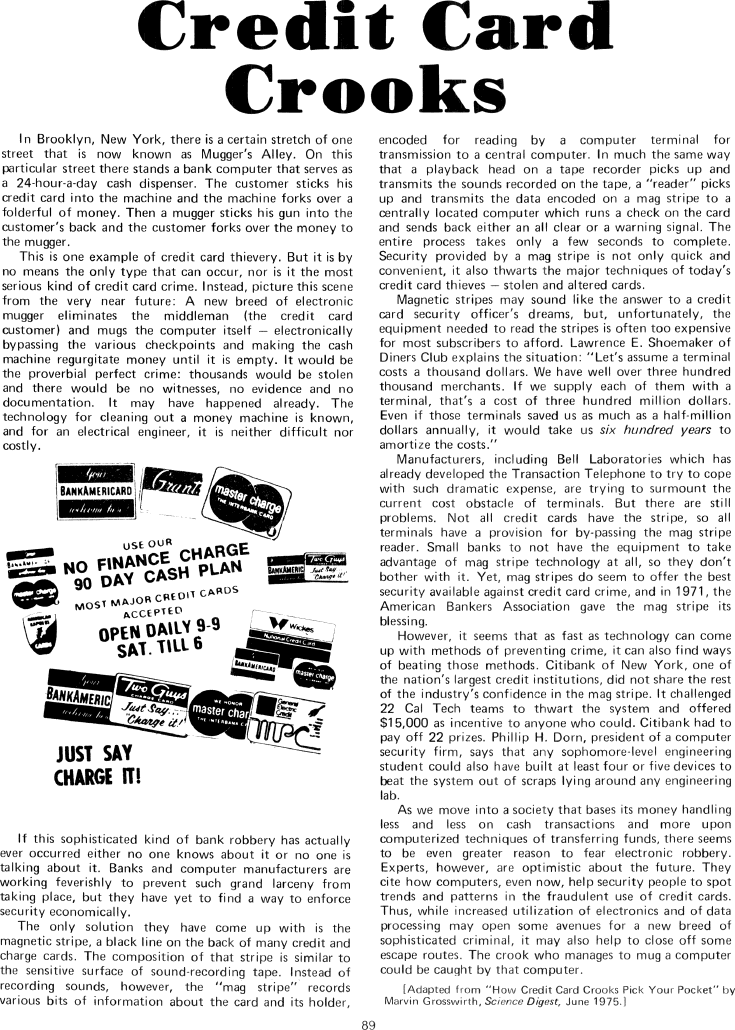The Best of Creative Computing Volume 1 (published 1976)
Credit Card Crooks (credit card crime)

Credit Card Crooks
In Brooklyn, New York, there is a certain stretch of one street that is now
known as Mugger's Alley. On this
particular street there stands a bank computer that serves as a 24-hour-a-day
cash dispenser. The customer sticks his credit card into the machine and the
machine forks over a folderful of money. Then a mugger sticks his gun into the
customer's back and the customer forks over the money to the mugger.
This is one example of credit card thievery. But it is by no means the only type
that can occur, nor is it the most serious kind of credit card crime. Instead,
picture this scene from the very near future: A new breed of electronic mugger
eliminates the middleman (the credit card customer) and mugs the computer itself
- electronically bypassing the various checkpoints and making the cash machine
regurgitate money until it is empty. It would be the proverbial perfect crime:
thousands would be stolen and there would be no witnesses, no evidence and no
documentation. It may have happened already. The technology for cleaning out a
money machine is known, and for an electrical engineer, it is neither difficult
nor costly.
[image] USE OUR NO FINANCE CHARGE 90 DAY CASH PLAN MOST MAJOR CREDIT CARDS
ACCEPTED OPEN DAILY 9-9 SAT. TILL 6 JUST SAY CHARGE IT
If this sophisticated kind of bank robbery has actually ever occurred either no
one knows about it or no one is talking about it. Banks and computer
manufacturers are working feverishly to prevent such grand larceny from taking
place, but they have yet to find a way to enforce security economically.
The only solution they have come up with is the magnetic stripe, a black line on
the back of many credit and
charge cards. The composition of that stripe is similar to the sensitive surface
of sound-recording tape. Instead of recording sounds, however, the "mag stripe"
records various bits of information about the card and its holder, encoded for
reading by a computer terminal for transmission to a central computer. In much
the same way that a playback head on a tape recorder picks up and transmits the
sounds recorded on the tape, a "reader" picks up and transmits the data encoded
on a mag stripe to a centrally located computer which runs a check on the card
and sends back either an all clear or a warning signal. The entire process takes
only a few seconds to complete. Security provided by a mag stripe is not only
quick and convenient, it also thwarts the major techniques of today's credit
card thieves - stolen and altered cards.
Magnetic stripes may sound like the answer to a credit card security officer's
dreams, but, unfortunately, the
equipment needed to read the stripes is often too expensive for most subscribers
to afford. Lawrence E. Shoemaker of Diners Club explains the situation: "Let's
assume a terminal costs a thousand dollars. We have well over three hundred
thousand merchants. If we supply each of them with a terminal, that's a cost of
three hundred million dollars. Even if those terminals saved us as much as a
half-million dollars annually, it would take us six hundred years to amortize
the costs."
Manufacturers, including Bell Laboratories which has already developed the
Transaction Telephone to try to cope with such dramatic expense, are trying to
surmount the current cost obstacle of terminals. But there are still problems.
Not all credit cards have the stripe, so all terminals have a provision for
by-passing the mag stripe reader. Small banks to not have the equipment to take
advantage of mag stripe technology at all, so they don't bother with it. Yet,
mag stripes do seem to offer the best security available against credit card
crime, and in 1971, the American Bankers Association gave the mag stripe its
blessing.
However, it seems that as fast as technology can come up with methods of
preventing crime, it can also find ways of beating those methods. Citibank of
New York, one of the nation's largest credit institutions, did not share the
rest of the industry's confidence in the mag stripe. It challenged 22 Cal Tech
teams to thwart the system and offered $15,000 as incentive to anyone who could.
Citibank had to pay off 22 prizes. Phillip H. Dorn, president of a computer
security firm, says that any sophomore-level engineering student could also have
built at least four or five devices to beat the system out of scraps lying
around any engineering lab.
As we move into a society that bases its money handling less and less on cash
transactions and more upon
computerized techniques of transferring funds, there seems to be even greater
reason to fear electronic robbery. Experts, however, are optimistic about the
future. They cite how computers, even now, help security people to spot trends
and patterns in the fraudulent use of credit cards, Thus, while increased
utilization of electronics and of data processing may open some avenues for a
new breed of sophisticated criminal, it may also help to close off some escape
routes. The crook who manages to mug a computer could be caught by that
computer.
[Adapted from "How Credit Card Crooks Pick Your Pocket" by Marvin Grosswirth,
Science Digest, June 1975.]
89


